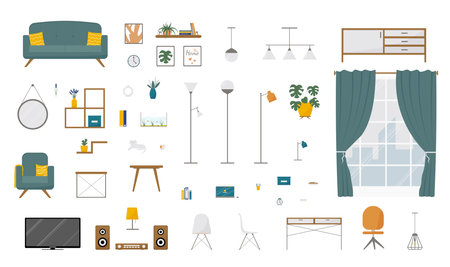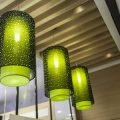Introduction to Smart Lighting and British Architectural Heritage
The evolution of smart lighting technology has brought about a quiet revolution in how we illuminate our homes and public spaces. In the United Kingdom, where centuries-old architecture is woven into the very fabric of daily life, the integration of contemporary lighting solutions presents both an exciting opportunity and a unique challenge. Traditional British architecture—whether it’s the dignified Georgian townhouse, the ornate Victorian villa, or the sturdy Edwardian terrace—boasts distinctive features such as sash windows, decorative cornices, stone facades, and intricate woodwork. These elements contribute not only to the aesthetic charm of Britain’s built environment but also to its cultural significance. As we explore how smart lighting can complement these architectural treasures, it becomes essential to consider both the technological capabilities of modern systems and the heritage values intrinsic to British design. By establishing this context, we set the stage for understanding how innovation and tradition can harmoniously coexist.
Essential Principles of Smart Lighting
Smart lighting systems have transformed the way we illuminate our homes and historic buildings, offering a synergy between modern technology and the timeless aesthetics of traditional British architecture. At their core, these systems leverage networked LED fixtures, intelligent sensors, and centralised control interfaces to deliver an adaptable and energy-conscious lighting experience. This is particularly significant in the UK context, where many properties blend period features with contemporary living standards.
One of the primary benefits of smart lighting is its energy efficiency. Modern LED bulbs consume significantly less power than traditional incandescent or halogen lamps—an important factor for both listed properties and new builds looking to reduce their environmental footprint. The ability to schedule lighting, dim lights automatically, or use occupancy sensors ensures that energy is only used when necessary.
| Feature | Traditional Lighting | Smart Lighting |
|---|---|---|
| Energy Consumption | High | Low (LED-based) |
| User Control | Manual switches | App, voice, schedules |
| Adaptability | Fixed brightness/colour | Dimmable, tunable white/RGB |
| Integration with Architecture | Limited (static fixtures) | Customisable for heritage spaces |
| Maintenance Frequency | Frequent bulb changes | Longer lifespan components |
Adaptability is another essential principle. In British homes—where layouts can be irregular and original features such as cornices, wood panelling, or stained glass are prevalent—smart lighting allows for custom scene-setting. For example, ambient settings can highlight architectural details without overwhelming the room’s character, while task lighting can be focused where it’s needed most.
The third pillar is user control. Through mobile apps or voice assistants popular in UK households (such as Amazon Alexa or Google Home), residents can easily adjust lighting conditions according to mood, time of day, or even external factors like weather. This flexibility also supports accessibility needs, which is increasingly important in Britain’s diverse housing stock.

3. Respecting Historic Character: Design Considerations
Integrating smart lighting within traditional British architecture, especially when dealing with Georgian, Victorian, or Edwardian properties, requires a thoughtful and respectful approach. The visual harmony and historic value of these buildings are central to their enduring appeal, and any modern intervention must be carefully calibrated to preserve their unique character.
One key consideration is the selection of lighting fixtures that complement rather than compete with original architectural features. For instance, choosing discreet fittings in muted metallic finishes or classic shapes helps ensure that the technology remains unobtrusive. Where possible, smart lighting controls can be integrated within existing switch locations or concealed behind period-appropriate fixtures, maintaining the authentic look while delivering all the benefits of modern technology.
The colour temperature and intensity of smart lights also play a crucial role. Warm white tones often harmonise better with traditional interiors, echoing the soft glow of historical gas lamps or early electric bulbs. Dimmable solutions allow for mood adjustments without compromising the atmosphere or overwhelming delicate plasterwork and wood panelling common to these heritage homes.
Finally, it’s essential to account for conservation requirements. Many listed buildings in the UK have regulations governing alterations. Working closely with local planning authorities and conservation officers ensures that smart lighting upgrades remain sympathetic to both visual aesthetics and legal standards. This collaborative approach not only protects the building’s historical integrity but also demonstrates a commitment to responsible stewardship of Britain’s architectural legacy.
4. Discreet Integration: Blending Modern Tech with Period Details
One of the central challenges in introducing smart lighting to traditional British architecture lies in achieving a seamless integration. The aim is to bring all the benefits of modern technology without disturbing the historical character and charm that define so many British homes and heritage buildings. This requires an appreciation for period details, as well as a practical understanding of local design sensibilities and materials.
Respecting Heritage while Embracing Innovation
British interiors are renowned for their ornate cornices, wood panelling, sash windows, and intricate ceiling roses. Installing smart lighting unobtrusively means working with – rather than against – these features. For instance, selecting smart bulbs compatible with existing fittings allows homeowners to retain original chandeliers or wall sconces, while still enjoying remote control and automation.
Practical Approaches for Unobtrusive Installation
| Approach | Description | Benefits |
|---|---|---|
| Retrofitting Existing Fixtures | Using smart bulbs or smart switches that fit into current light fixtures. | Maintains period aesthetics; no need for visible rewiring. |
| Wireless Control Solutions | Utilising battery-powered or wireless wall switches and sensors. | Avoids damage to plasterwork or mouldings; easy to relocate if needed. |
| Bespoke Cover Plates & Finishes | Customising visible components (e.g., switch plates) in brass, porcelain, or wood grain finishes. | Keeps technology discreet and consistent with traditional materials. |
| Recessed & Hidden Lighting | Installing LED strips behind cornices or within cabinetry. | Adds ambience without visible modern fittings; highlights period features. |
Utilising British Materials and Craftsmanship
The use of authentic materials is key. For example, when updating a Victorian terrace or Georgian townhouse, it’s possible to source period-appropriate metalwork or hand-painted ceramic faceplates for smart switches. Collaborating with local artisans ensures any new technology feels like a natural extension of the original design, rather than an intrusion.
Sensitivity to Exterior Features
For exteriors, discrete pathway lights can be installed among traditional stone paving, with fixtures powder-coated in heritage colours such as black or deep green. Motion-sensor smart lanterns designed in classic forms offer both security and visual harmony, supporting the stately look of brick facades and wrought iron gates.
Summary: Harmonising Old and New
The success of smart lighting in traditional British architecture depends on thoughtful planning and respect for context. By leveraging retrofit solutions, bespoke finishes, and craftsmanship rooted in local traditions, it is entirely possible to enhance comfort and functionality without compromising on historic charm. Ultimately, this discreet integration represents the best of both worlds: technological convenience paired with timeless style.
5. Highlighting Heritage Features with Light
One of the most compelling advantages of smart lighting in traditional British architecture is its ability to sensitively enhance heritage features without overshadowing them. Many period homes and buildings across the UK are defined by intricate cornices, decorative mouldings, timber beams, and exquisite stained glass. These elements deserve to be celebrated, yet require careful handling to avoid diminishing their historical character.
Modern smart lighting systems offer precise control over direction, intensity, and even colour temperature, allowing homeowners and designers to tune illumination specifically for each feature. For example, a softly directed warm-white light can accentuate the delicate relief of a Georgian ceiling rose, casting subtle shadows that bring out its craftsmanship without drawing undue attention. Similarly, tunable white or gentle RGBW fixtures can be used to highlight stained glass windows, adjusting tone throughout the day to complement natural daylight or create atmospheric evening effects.
The key here lies in restraint and consideration. Overly bright or poorly positioned lighting risks flattening details or causing glare—issues that smart technology helps avoid through dimming capabilities and programmable scenes. By calibrating each luminaire for its intended effect, it is possible to gently wash a Victorian archway or Tudor panelling with light that enriches textures and colours, rather than washing them out.
This approach not only enhances the visual appeal but also supports the preservation ethos underpinning much of British heritage conservation. Smart systems allow these sensitive adjustments to be made with minimal intervention—often requiring no physical alteration to listed structures—thus respecting both the fabric and spirit of the original architecture.
Sustainability and Efficiency Benefits for UK Properties
When considering the integration of smart lighting within the rich tapestry of Britain’s older building stock, the conversation naturally turns towards sustainability and efficiency. Many traditional British homes and heritage properties were constructed long before modern energy standards became commonplace, often resulting in higher energy consumption and increased running costs. Smart lighting offers a tangible solution to these enduring challenges by introducing a layer of intelligent control and automation tailored to the unique requirements of historic architecture.
One of the key advantages lies in reduced energy consumption. Smart lighting systems employ LED technology, which is significantly more efficient than incandescent or halogen bulbs commonly found in older properties. Coupled with motion sensors, daylight harvesting, and automated scheduling, these systems ensure that lights are only used when necessary. For example, occupancy sensors can automatically switch off lights in unused rooms—a particularly valuable feature in sprawling Victorian terraces or large Georgian townhouses.
Lower energy bills naturally follow improved efficiency. UK homeowners are increasingly conscious of rising utility costs; smart lighting addresses this concern by providing detailed usage insights and remote control via smartphone apps or central panels. This empowers residents to monitor and adjust their lighting habits, making small changes that accumulate into noticeable savings over time without compromising comfort or the visual integrity of period interiors.
Beyond financial considerations, there is a pressing environmental imperative. Retrofitting smart lighting into Britain’s existing buildings helps reduce overall carbon emissions associated with domestic electricity use. With government targets focused on achieving net zero by 2050, every effort to decrease a property’s environmental footprint counts—especially when those efforts can be made without altering cherished architectural features. In this way, smart lighting supports both national sustainability goals and local conservation priorities.
It is worth noting that many listed buildings face restrictions on structural alterations; here, smart lighting’s flexibility shines. Wireless solutions minimise invasive wiring and preserve original walls and ceilings while still delivering modern efficiency benefits. This approach respects the heritage value of the property while future-proofing it for generations to come.
In summary, the thoughtful implementation of smart lighting brings measurable sustainability benefits to traditional British homes: reducing energy consumption, lowering bills, and shrinking environmental impact—all while honouring the character and history embedded within Britain’s architectural legacy.
7. Conclusion: Marrying the Old with the New
In reflecting on how smart lighting complements traditional British architecture, it becomes clear that technology and heritage need not exist in opposition. Instead, when thoughtfully integrated, smart lighting brings out the best in historic spaces, highlighting their unique features while providing the comfort, efficiency, and adaptability that modern living demands. From Georgian townhouses to Victorian terraces and even centuries-old cottages, these buildings can retain their quintessential charm while embracing contemporary needs.
The broader value of adopting smart lighting in such settings lies in its ability to bridge eras. It allows us to honour the craftsmanship and character of Britain’s architectural past without compromising on sustainability or functionality. Through careful planning and respect for original design elements, smart lighting solutions discreetly blend into period interiors or exteriors, illuminating details that might otherwise go unnoticed and creating moods that celebrate both history and innovation.
Ultimately, this marriage of old and new is more than just an aesthetic upgrade; it is a commitment to ensuring that Britain’s traditional buildings remain vibrant and relevant spaces for generations to come. By investing in smart lighting, homeowners and custodians of heritage properties can future-proof these treasured structures—keeping them beautiful, liveable, and truly fit for contemporary life.


